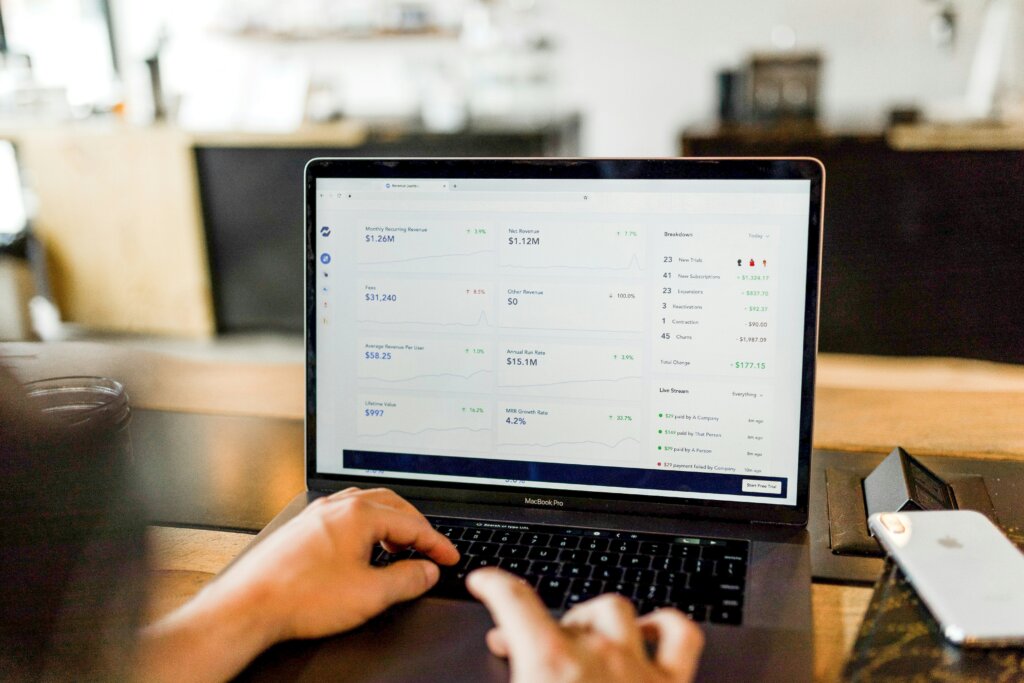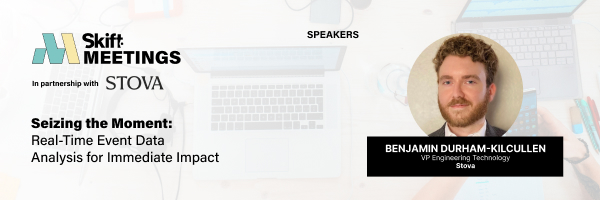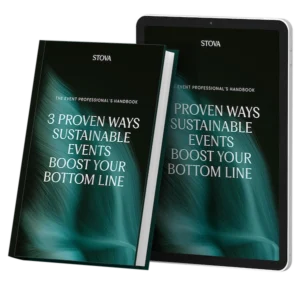7 Ways Event Data Drives Success: From Registration to ROI
July 11, 2024
Industry research shows in-person events are the most trusted channel in an integrated marketing plan. With the phasing out of online cookies, events have also become one of the most effective ways to gather first-party data. For savvy meeting professionals, event data is a goldmine hiding in plain sight – if you know how to find it.
To help make the most of the opportunities before you, Stova joined Skift Meetings last month in a webinar entitled “Seizing the Moment: Real-Time Event Data Analysis for Immediate Impact.”
Stova’s Vice President of Engineering, Ben Durham-Kilcullen, explained how event technology can help you master real-time event data analysis to nurture leads and ratchet up return on investment (ROI).
This article shares webinar highlights. By reading it, you’ll discover how to use data to:
- Understand your audience better
- Capture qualified leads
- Drive sales pipeline
- Rocket event ROI
Let’s get started.

What is event data analysis?
Event data analysis slices and dices information you gather throughout the event lifecycle. The goal is to provide insights into attendee preferences and pain points.
Why is real-time event data analysis important?
This business intelligence helps you understand attendees better, so you can personalize their journey and improve event impact. Having these insights at your fingertips in real-time means you can make informed decisions fast to drive positive outcomes.
1. Set the stage for success.
The trouble is, events generate a vast amount of information. When attendees opt-in, every click, swipe, and digital interaction is trackable.
So, how do you know what data to capture? The answer lies in having a strategic plan.
Pre-event, create key performance indicators (KPIs) that support your event goals. Effective KPIs are specific and measurable. For example, they may include metrics for attendance, lead generation, and sales conversions.
Use an all-in-one events management system (EMS) to collect data that aligns with your KPIs. And gather real-time information pre-, during and post-event.
2. Capture data during registration.
Which industries are your attendees in? What are their job titles? In what regions do they live? Which event sessions do they plan to attend?
These are just a few of the questions you can answer by analyzing event registration data. This business intelligence helps you ensure attendees and stakeholders get the most from your event.
While registration data reveals attendee interests, you can also view information in a different light and learn a lot from the inverse.
For example, what sessions are attendees not selecting? Which formats are getting the least traction? What speaker bios are attracting less than their fair share of clicks?
Dig deeper with surveys.
For more insights, add a brief survey to your event registration form. Drill down to find new ways to engage and delight attendees. For example, ask questions to discover their:
- Expectations for the event
- Thoughts about its location
- Networking preferences
- Topics or speakers of greatest interest
- Preferred formats, such as workshops, keynotes, and hands-on demos
Improve outcomes.
Armed with this intel, you can take immediate action to enrich your events in many ways.
For starters, recommend sessions and networking opportunities to connect attendees who share interests or industry challenges. Also add sessions, reallocate staffing, and adjust formats to fit attendee preferences.
What if the data reveals a critical market segment is underperforming?
You can make changes on the fly to reach the right people with the right message and give registration a boost.
3. Monitor onsite behavior to discover attendee interests.
Digital badges are game-changers for event data analysis. They provide the insights you need to personalize attendee experiences.
Choose the right digital badging system.
When eventgoers opt in, badging solutions enable attendee tracking. The technology gives you a window into their interests and pain points. Choose tracking tools based on use case, as shown below.
- Near Field Communication (NFC) technology is great for short-range, secure transactions. Among the many uses, these tap-and-go solutions power speedy session check-in.
- Quick response (QR) codes power event registration and access, too. Attendees scan a QR code from their mobile phones for fast, easy check-in. This handy tool also drives event engagement, networking, gamification, and more.
- Bluetooth low energy (BLE) is a wireless communication system. Combine BLE badges with beacons and heat mapping. You’ll uncover traffic info like footfall and dwell time in sessions and across the show floor. Use this intel to find out attendee interests and improve engagement.
- Beacons and tracking tools also help you identify hot and cold spots throughout your event. Create activations, like impromptu performances and social media walls. Then take advantage of real-time data to attract people to areas where traffic is low.
4. Capture qualified leads.
Using digital badging, exhibitors can collect leads at their booths with a quick, easy scan.
According to the Freeman 2024 Exhibitors Trends Report, lead generation is the most important component of event success. Exhibitors also say effective lead gen is about measuring the quality of connections, not just the quantity of them.
So, how do you generate the qualified leads exhibitors crave?
Dig deeper with sentiment analysis and lead scoring.
Durham-Kilcullen recommends leveling up lead retrieval with these tools below.
- Sentiment analysis: Using push notifications, invite attendees to tell you how they feel about an event experience. Ask them in real-time while the experience is fresh in their minds. Probe deeper to learn what made it positive or negative for them.
- Lead scoring: Qualify leads by asking questions to gauge interest in specific products and services. Maybe attendees are shopping around. Maybe they have some interest in an exhibitor’s products, which led them to the booth.
Insights from sentiment analysis and lead scoring empower exhibitors to finetune their outreach and increase conversions.
5. Personalize with AI and machine learning.
Modern platforms like Stova consolidate registration and onsite behavioral data.
Then, artificial intelligence and machine learning analyze this information and send real-time recommendations on sessions and networking opportunities. In the blink of an eye, attendees and exhibitors receive personalized suggestions in push notifications through the event app.
Enrich the experience.
AI adds value by:
- Forging relationships among like-minded people
- Streamlining networking
- Sending exhibitors qualified leads
- Notifying attendees about relevant sessions they might otherwise miss
- Acting as a personal assistant, helping eventgoers customize their agendas and schedule meetings with ease.
6. Drive the sales pipeline.
Consolidating event data is crucial for sales teams. They need this information at their fingertips to follow up on leads effectively.
Best Practices
- To this end, streamline data flow to your customer relationship management (CRM) system.
- Leverage automatic lead scoring to simplify event follow-up.
For example, set behavioral thresholds or weights on specific questions. Let’s say an attendee stays at a booth for 15 minutes. Booth dwell time can influence the likelihood of conversions. Setting automated thresholds helps pare down your data and make it manageable.
Sales teams identify targeted leads and connect with them fast with customized content.
7. Measure event ROI
Consolidating event data also helps marketing teams prove event impact.
By linking your EMS and CRM systems, you can follow hot leads from events throughout the buyer’s journey and find out when a lead eventually closes.
In short, you create a trail, so credit goes where credit is due. And you show with hard data how your event contributes to the company’s bottom line.
Wrapping up
As you can see, event data analysis helps you enhance the attendee experience throughout your event. When you know how to mine data, you glean precious insights to boost registration, engagement, and event ROI.
Ready to add more value to your events?
Download our free webinar with Skift Meetings, “Seizing the Moment: Real-Time Event Data Analysis for Immediate Impact.”

Whether your event is virtual, hybrid, or in-person, enhance your attendee’s journey with an event ecosystem built for your audience. Ready to walk through Stova's event technology solutions? Schedule some time with us today.

